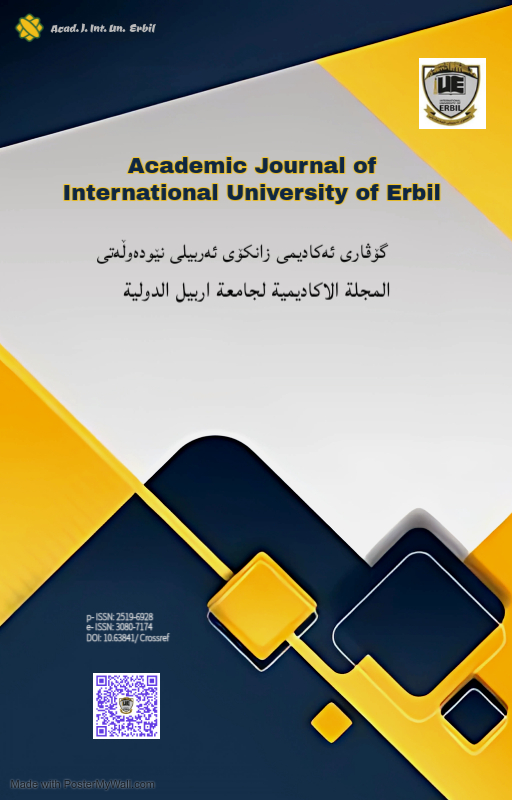Financial Market Development and its Implication on Economic Performance: Evidence from APEC countries
Financial Market Development and its Implication on Economic Performance
DOI:
https://doi.org/10.63841/iue22595Keywords:
Financial market growth, Market capitalization, Market efficiency, FDI, Macroeconomic performance, National incomeAbstract
Establishing a strong financial market could help countries economically by acting as an accelerator. It has been discovered that countries with robust stock markets promote the creation of decent jobs, improve national income, and support economic expansion that is consistent with long-term economic growth. This study aimed to investigate the effect of financial market development on economic performance among the Asia-Pacific Economic Cooperation (APEC) countries. The data, which spans the prior 32 years from 1991 to 2022, has been collected from reputable databases, such as Internal Monetary Fund (IMF) and World Bank Data. The Fixed effect model with GLS cross-section weight was used to assess the above association. The findings display that FDI has a positive but insignificant influence on economic performance measured by (GNI and GDP). MAC has an adverse impact on GNI, but it has a beneficial impact on GDP, suggesting that although the stock market drives economic growth, its influence on national income is insignificant. Efficiency in the financial markets increases GDP but also increases disparities in income distribution, whereas depth in the financial markets increases GNI but reduces GDP growth. The results emphasize the necessity of balanced approaches to achieve equitable and sustained economic performance. To encourage economic growth, policymakers should give priority to fostering stock market expansion, lowering disparities in income distribution, and enhancing the effectiveness of the financial system. Sustainable economic growth, higher income level, and enhancing general social well-being are three benefits of putting these aims into practice.
References
R. Arezki and T. Gylfason, "Commodity price volatility, democracy, and economic growth", Economic Growth and Development (Fron. of Econ. and Glob.), vol. 11, pp. 9-24, 2011. doi: 10.1108/S1574-8715(2011)0000011007.
T. V. Cavalcanti, K. Mohaddes and M. Raissi, “Commodity Price Volatility and The Sources of Growth,” J. Appl. Econom., vol. 30, pp. 857–873, 2015, doi: 10.1002/jae.2407.
B. K. Guru and I. S. Yadav, “Financial development and economic growth: panel evidence from BRICS,” J. Econ. Financ. Adm. Sci., vol. 24, no. 47, pp. 113–126, 2019, doi: 10.1108/JEFAS-12-2017-0125.
B. Setiawan, A. Saleem, R. J. Nathan, Z. Zeman, R. Magda and J. Barczi, “Financial market development and economic growth: Evidence from asean and cee region,” Polish J. Manag. Stud., vol. 23, no. 2, pp. 481–494, 2021, doi: 10.17512/pjms.2021.23.2.29.
J. A. Schumpeter, “The Theory of Economic Development (Theorie der wirtschaftlichen entwicklung),” Leipzig: Duncker & Humblot, 1912.
R. Levine and S. Zervos, “Stock Markets, Banks, and Economic Growth,” Am. Econ. Rev., vol. 88, no. 3, pp. 537–558, 1998, http://www.jstor.org/stable/116848
M. N. Alsalamat and J. A. Alzyadat, “Bank-Based and Market-Based Financial Systems Structure and Economic Growth in Saudi Arabia,” Rev. Econ & Financ., vol. 21, pp. 2847–2854, 2023.
World Bank, “GDP growth (annual %),” 2024. https://data.worldbank.org/indicator/NY.GDP.MKTP.KD.ZG
I. Matei, “Is financial development good for economic growth? Empirical insights from emerging European countries,” Quant. Financ. Econ., vol. 4, no. 4, pp. 653–678, 2020, doi: 10.3934/qfe.2020030.
B. Erika and I. Hágen Zsombor, “BSC modellel a kereskedelmi tevékenységet ellenőrző vállalkozások versenyképességének növeléséért,” Controll. INFO, vol. 3, no. 1, pp. 42–46, 2015.
E. Wasmer and P. Weil P., “The Macroeconomics of Labor and Credit Market Imperfections,” Am. Econ. Rev., vol. 94, no. 4, pp. 944–963, 2004, http://www.jstor.org/stable/3592800
A. Shahid, H. Saeed and S. M. A. Tirmizi, “Economic development and banking sector growth in Pakistan,” J. Sustain. Financ. Invest., vol. 5, no. 3, pp. 121–135, 2015, doi: 10.1080/20430795.2015.1063976.
P. T. Nguyen, “The Impact of Banking Sector Development on Economic Growth: The Case of Vietnam’s Transitional Economy,” J. Risk Financ. Manag., vol. 15, no. 8, 2022, doi: 10.3390/jrfm15080358.
K. Purewal and H. Haini, “Re-examining the effect of financial markets and institutions on economic growth: evidence from the OECD countries,” Econ. Chang. Restruct., vol. 55, no. 1, pp. 311–333, 2022, doi: 10.1007/s10644-020-09316-2.
F. Balázs and B. N. Patrícia, “The role of venture capital in the bridging of funding gaps – A real options reasoning,” Annals of University of Oradea - Economic Science, vol.24, no. 1, pp. 825-830, 2015.
A. Singh and B. A. Weisse, “Emerging Stock Markets, Portfolio Capital Flows and Economic Growth: Micro and Perspectives Macroeconomic,” pp. 607–622, 1998.
A. M. Ahmed, N. A. Sharif, M. N. Ali and I. Hágen, “Effect of Firm Size on the Association between Capital Structure and Profitability,” Sustain., vol. 15, no. 14, pp. 1–17, 2023, doi: 10.3390/su151411196.
S. R. Sdiq and H. A. Abdullah, “The Moderating Effect of Agency Cost on the Relationship Between Capital Structure and Financial Performance: Evidence of an Emerging Market”, QALAAI ZANIST J., vol. 8, no. 3, pp. 1239–1266, 2023, doi: 10.25212/lfu.qzj.8.3.51.
S. R. Sdiq and H. A. Abdullah,, “Examining the effect of agency cost on capital structure-financial performance nexus: empirical evidence for emerging market,” Cogent Econ. Financ., vol. 10, no. 1, pp. 1-16, 2022, doi: 10.1080/23322039.2022.2148364.
H. Abdullah and T. Tursoy, “Capital structure and firm performance: evidence of Germany under IFRS adoption,” Rev. Manag. Sci., vol. 15, no. 2, pp. 379–398, 2021, doi: 10.1007/s11846-019-00344-5.
A. M. Ahmed, M. N. Ali and I. Hágen, “Corporate Governance and Capital Structure: Evidence from Europe,” Int. J. Prof. Bus. Rev., vol. 8, no. 7, pp. 1–22, 2023, doi: 10.3390/su151411196.
K. Kravec and D. Jurevičienė, “The Impact of Financial Systems on Economic Growth,” In 12th Int. Scient. Conf. Bus. Manag., May 12–13, 2022, Vilnius, Lithuania, 2022, doi: 10.3846/bm.2022.917
T. Beck and R. Levine, “Stock markets, banks, and growth: Panel evidence,” J. Bank. Financ., vol. 28, no. 3, pp. 423–442, 2004, doi: 10.1016/S0378-4266(02)00408-9.
M. Yunus, B. Setiawan, P. R. Bhagat and A. Saleem, “Financial Market Development on Economic Growth in Indonesia Using Principal Component Regression Analysis,” J. Akunt. dan Keuang., vol. 10, no. 1, p. 83-92, 2022, doi: 10.29103/jak.v10i1.6525.
M. S. Rapp and I. A. Udoieva, “What matters in the finance–growth nexus of advanced economies? Evidence from OECD countries,” Appl. Econ., vol. 50, no. 6, pp. 676-690, 2018, doi: 10.1080/00036846.2017.1337867.
A. Sakti, “Proposing New Islamic Microfinance Model for Sustainable Islamic Microfinance Institution,” In: Hassan, M.K., Saraç, M., Khan, A. (eds) Islamic Finance and Sustainable Development. Palgrave Macmillan, Cham, pp. 349-386, 2021. doi: 10.1007/978-3-030-76016-8_15.
P. N. Senadheera and C. Rajapakse, “Impact of financial market development on economic growth: evidence from Sri Lanka,” Sri Lanka J. Soc. Sci., vol. 46, no. 1, pp. 99–123, 2023, doi: 10.4038/sljss.v46i1.8634.
D. Wahidin, A. Akimov and E. Roca, “The impact of bond market development on economic growth before and after the global financial crisis: Evidence from developed and developing countries,” Int. Rev. Financ. Anal., vol. 77, pp. 1-11, 2021, doi: 10.1016/j.irfa.2021.101865.
R. Ginevičius, J. Nazarko, D. Gedvilaitė and Z. Dacko-Pikiewicz, “Quantifying the economic development dynamics of a country based on the Lorenz curve,” E a M Ekon. a Manag., vol. 24, no. 1, pp. 55–65, 2021, doi: 10.15240/TUL/001/2021-1-004.
A. Demirgüç-Kunt and R. Levine, “Stock markets, corporate finance, and economic growth: An overview,” World Bank Econ. Rev., vol. 10, no. 2, pp. 223–239, 1996, doi: 10.1093/wber/10.2.223.
M. Regan, “Capital markets, infrastructure investment and growth in the Asia pacific region,” Int. J. Financ. Stud., vol. 5, no. 1, 2017, doi: 10.3390/ijfs5010005.
L. Alfaro, A. Chanda, S. Kalemli-Ozcan and S. Sayek, “FDI and economic growth: The role of local financial markets,” J. Int. Econ., vol. 64, no. 1, pp. 89–112, 2004, doi: 10.1016/S0022-1996(03)00081-3.
B. Elvira and I. Hágen , “Menedzsment Control-A Számviteli Mutatószámoktól A Versenyképes Stratégiáig,” Act. Carol. Rob., vol. 7, no. 2, pp. 19–36, 2017.
A. M. Acquah and M. Ibrahim, “Foreign direct investment, economic growth and financial sector development in Africa,” J. Sustain. Financ. Invest., vol. 10, no. 4, pp. 315–334, 2020, doi: 10.1080/20430795.2019.1683504.
K. H. Mustafa and A. M. Ahmed, “A Critical Review of the Market Efficiency Concept,” Shirkah J. Econ. Bus., vol. 5, no. 2, pp. 271-285, 2020, doi: 10.22515/shirkah.v5i2.326.
F. Balázs and B. N. Patrícia, “Mit jelez a tulajdonosi szerkezet? – A tulajdonosi szerkezet és a vállalkozások teljesítményének kapcsolata információs aszimmetriák mellett a magyarországi kockázatitőke-befektetések tükrében,” Vezetéstudomány, vol. 50, no. 7–8, pp. 31–38, 2019, doi: 10.14267/VEZTUD.2019.07.03.
M. Mahmood and K. U. Rehman, “Did Capital Market Development and Financial Depth Contribute to Growth? Evidence from European Financial Integration,” Eur. Rev., vol. 27, no. 4, pp. 506-518, 2019, doi: 10.1017/S1062798719000164.
T. Türsoy and F. Faisal, “Does financial depth impact economic growth in North Cyprus?,” Financ. Innov., vol. 4, no. 12, pp. 1-13, 2018, doi: 10.1186/s40854-018-0096-y.
I. O. Shkolnik and E. O. Kravchenko, “The Dependence of Economic Growth and the Depth of the Financial Market,” Бізнес Інформ, no. 2, pp. 190–195, 2015.
S. H. Law and N. Singh, “Does too much finance harm economic growth?,” J. Bank. Financ., vol. 41, no. 1, pp. 36–44, 2014, doi: 10.1016/j.jbankfin.2013.12.020.
N. Nofrianto, D. P. Nugraha, A. M. Ahmed, Z. Muttaqin, M. Fekete-Farkas, and I. Hágen, “Exploring the Resilience of Islamic Stock in Indonesia and Asian Markets,” J. Risk Financ. Manag., vol. 17, no. 6, pp. 1-16, 2024, doi: 10.3390/jrfm17060239.
P. C. B. Phillips and P. Perron, “Testing for a unit root in time series regression,” Biometrika, vol. 75, no. 2, pp. 335–346, 1988, doi: 10.1093/biomet/75.2.335.
R. D. F. Harris and E. Tzavalis, “Inference for unit roots in dynamic panels where the time dimension is fixed,” J. Econom., vol. 91, no. 2, pp. 201–226, 1999, doi: 10.1016/S0304-4076(98)00076-1.
P. Newbold, W. Carlson and B. Thorne, “Statistics for Business and Economics: Global Edition,” 8th ed., Pearson, Boston, 2013.
J. Bai, S. H. Choi and Y. Liao, “Feasible generalized least squares for panel data with cross-sectional and serial correlations,” Empir. Econ., vol. 60, no. 1, pp. 309–326, 2021, doi: 10.1007/s00181-020-01977-2.
A. M. Ahmed, D. P. Nugraha and I. Hágen, “The Relationship between Capital Structure and Firm Performance: The Moderating Role of Agency Cost,” Risks, vol. 11, no. 6, pp. 1–17, 2023, doi: 10.3390/risks11060102.
A. Y. H. Saif-Alyousfi, R. Md-Rus, K. N. Taufil-Mohd, H. M. Taib and H. K. Shahar, “Determinants of capital structure: evidence from Malaysian firms,” Asia-Pacific J. Bus. Adm., vol. 12, no. 3/4, pp. 283-326, 2020, doi: 10.1108/APJBA-09-2019-0202.
Downloads
Published
Issue
Section
License
Copyright (c) 2025 Academic Journal of International University of Erbil

This work is licensed under a Creative Commons Attribution 4.0 International License.












